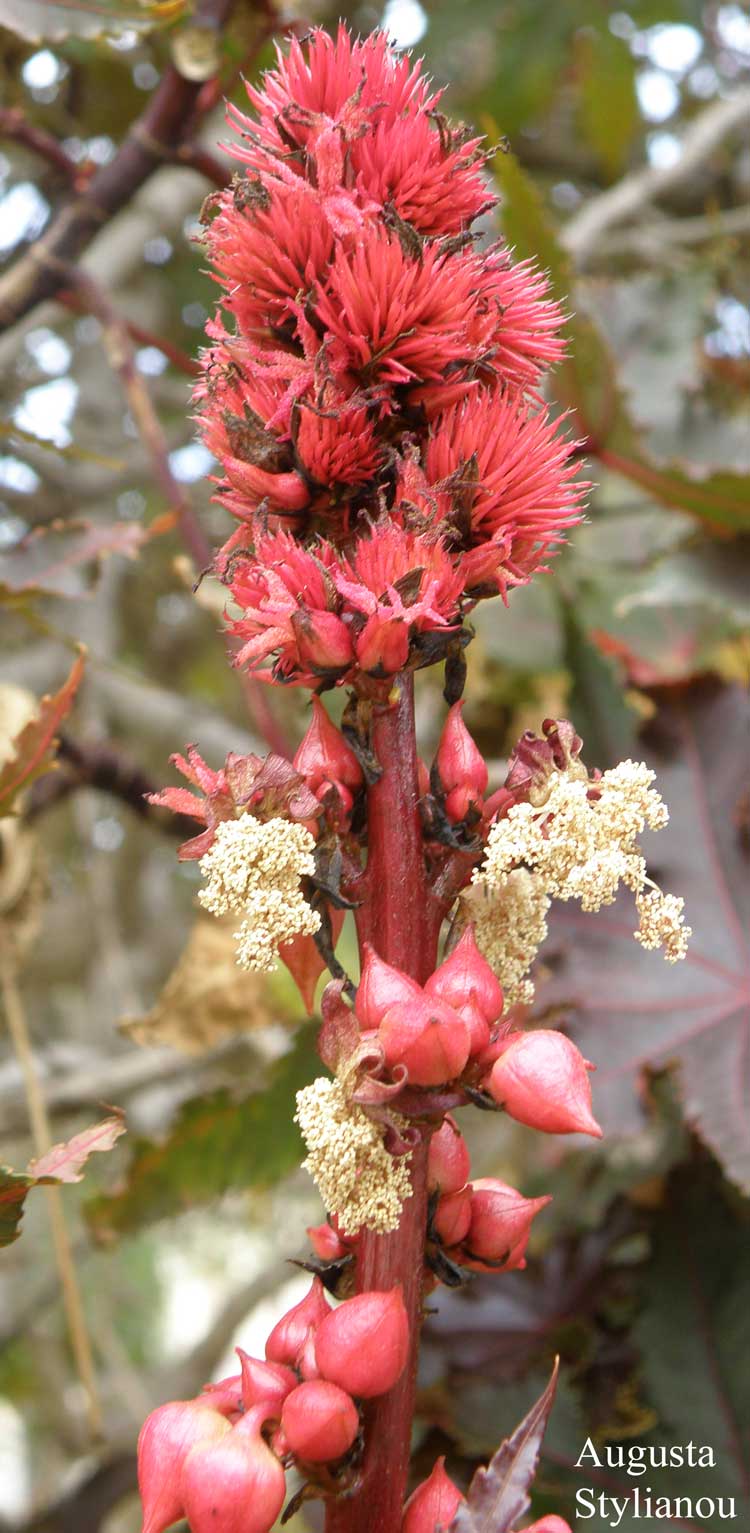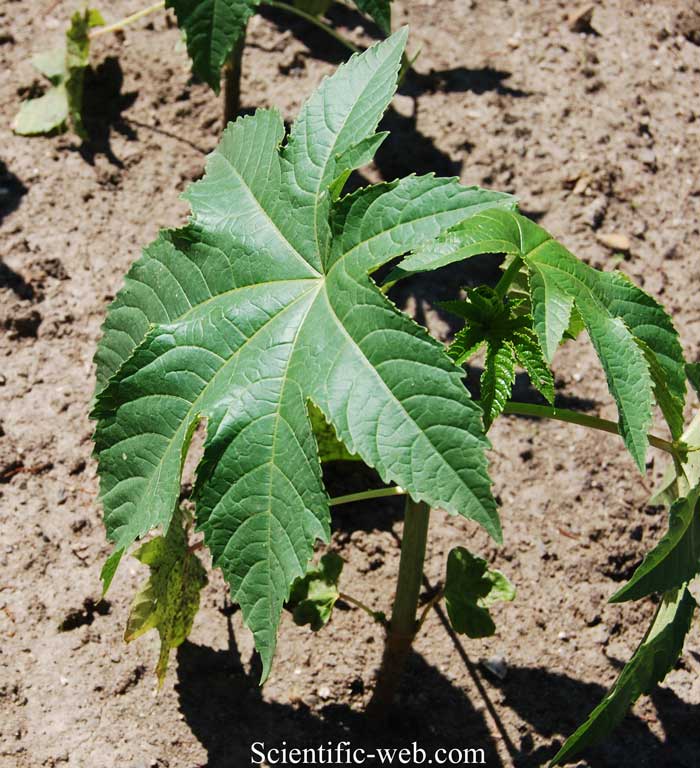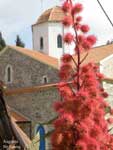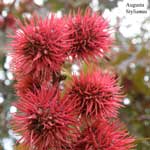
Ricinus communis in Cyprus, Photo: Augusta Stylianou Artist
Cladus: Eukaryota
Regnum: Plantae
Divisio: Magnoliophyta
Classis: Magnoliopsida
Ordo: Malpighiales
Familia: Euphorbiaceae
Subfamilia: Acalyphoideae
Tribus: Acalypheae
Genus: Ricinus
Species: Ricinus communis
Name
Ricinus communis L.

Ricinus communis, Photo: Michael Lahanas
Vernacular names
Internationalization
Česky: Skočec obecný
Deutsch: Wunderbaum
Ελληνικά: Ρετσινολαδιά
English: Castor oil plant
Español: Ricino
Türkçe: Hintyağı bitkisi
Arabic: Khirwa' خروع
Brazil: Carrapateiro, mamona
Ethiopia: Gulo
Dhivehi: Aamanaka, އާމަނަކަ
India: Tamil - Aamanakku (ஆமணக்கு), Hindi - AranDi,Gujarati - Divel, Kannada - AraLenne, Marathi - Erand, Telugu - Aavadam, Malayalam - Aavanakku, Bangla - Erando, Assamese, telugu Aamudalu
Indonesia: Jarak (Java), Dulang/ Gloah (Sumatera)
Iran: Karchak, کرچک
Kurdish: Gerchek, گهرچهک
Mexico: Higuerilla Nicaragua: Higuera or higueria
Portugal: Figueira do Diabo
Puerto Rico: Higuereta
Chinese: 蓖麻
Colombia: Aceite de Ricino Japan: 足車豆
References
* Species Plantarum 2:1007. 1753
* USDA, ARS, National Genetic Resources Program. Germplasm Resources Information Network - (GRIN) [Data from 07-Oct-06]. [1]
Images


Ricinus communis, Ricinus communis,
The castor oil plant, Ricinus communis, is a species of flowering plant in the spurge family, Euphorbiaceae. It belongs to a monotypic genus, Ricinus, and subtribe, Ricininae. The evolution of castor and its relation to other species is currently being studied.[1]
Its seed is the castor bean which, despite its name, is not a true bean. Castor is indigenous to the southeastern Mediterranean Basin, Eastern Africa, and India, but is widespread throughout tropical regions (and widely grown elsewhere as an ornamental plant).[2]
Castor seed is the source of castor oil, which has a wide variety of uses. The seeds contain between 40% and 60% oil that is rich in triglycerides, mainly ricinolein. The seed contains ricin, a toxin, which is also present in lower concentrations throughout the plant.
Another plant species, Fatsia japonica, is similar in appearance and is known as the false castor oil plant.
Description
Female (top) and male flowers
The castor oil plant can vary greatly in its growth habit and appearance. The variability has been increased by breeders who have selected a range of cultivars for leaf and flower colours, and for oil production. It is a fast-growing, suckering perennial shrub which can reach the size of a small tree (around 12 metres / 39 feet), but it is not cold hardy.
The glossy leaves are 15–45 centimetres (5.9–18 in) long, long-stalked, alternate and palmate with 5–12 deep lobes with coarsely toothed segments. In some varieties they start off dark reddish purple or bronze when young, gradually changing to a dark green, sometimes with a reddish tinge, as they mature. The leaves of some other varieties are green practically from the start, whereas in yet others a pigment masks the green colour of all the chlorophyll-bearing parts, leaves, stems and young fruit, so that they remain a dramatic purple-to-reddish-brown throughout the life of the plant. Plants with the dark leaves can be found growing next to those with green leaves, so there probably is only a single gene controlling the production of the pigment in some varieties at least.[3] The stems (and the spherical, spiny seed capsules) also vary in pigmentation. The fruit capsules of some varieties are more showy than the flowers.
The flowers are borne in terminal panicle-like inflorescences of green or, in some varieties, shades of red monoecious flowers without petals. The male flowers are yellowish-green with prominent creamy stamens and are carried in ovoid spikes up to 15 centimetres (5.9 in) long; the female flowers, born at the tips of the spikes, have prominent red stigmas.[4]
The fruit is a spiny, greenish (to reddish purple) capsule containing large, oval, shiny, bean-like, highly poisonous seeds with variable brownish mottling. Castor seeds have a warty appendage called the caruncle, which is a type of elaiosome. The caruncle promotes the dispersal of the seed by ants (myrmecochory).
Nomenclature
The name Ricinus is a Latin word for tick; the seed is so named because it has markings and a bump at the end which resemble certain ticks. The common name "castor oil" probably comes from its use as a replacement for castoreum, a perfume base made from the dried perineal glands of the beaver (castor in Latin). It has another common name, palm of Christ, or Palma Christi, that derives from castor oil's reputed ability to heal wounds and cure ailments.
Medicinal Uses (other than oil)
Alcoholic extract of the leaf was hepatoprotective in rats [5].[6],[7]
Methanolic extracts of the leaves of Ricinus communis were used Antimicrobial testing against eight pathogenic bacteria in rats and showed antimicrobial properties. The extract was not toxic.[8]
Pericarp of Castor bean showed CNS stimulant effects in mice at low doses. At lower doses, the extract improved memory consolidation. At high doses mice quickly died.[9]
A water extract of the root bark showed analgesic activity in rats.[10]
Antihistamine and anti-inflammatory properties found in ethanolic extract of Ricinus communis root bark.[11]
Other uses
Extract of Ricinus communis, exhibited acaricidal and insecticidal activities against the adult of Haemaphysalis bispinosa Neumann (Acarina: Ixodidae) and hematophagous fly Hippobosca maculata Leach (Diptera: Hippoboscidae).[12]
Habitat, growth and horticultural uses
In Greece it is hardy enough to grow as a small tree. In northern countries it is grown instead as an annual.
Although castor is indigenous to the southeastern Mediterranean Basin, Eastern Africa, and India, today it is widespread throughout tropical regions.[2] In areas with a suitable climate, castor establishes itself easily as an apparently "native" plant and can often be found on wasteland.
It is also used extensively as a decorative plant in parks and other public areas, particularly as a "dot plant" in traditional bedding schemes. If sown early, under glass, and kept at a temperature of around 20 °C (68 °F) until planted out, the castor oil plant can reach a height of 2–3 metres (6.6–9.8 ft) in a year. In areas prone to frost it is usually shorter, and grown as if it were an annual.[2] However, it can grow well outdoors in cooler climates, at least in Southern England, and the leaves do not appear to suffer frost damage in sheltered spots, where it remains evergreen. It was used in Edwardian times in the parks of Toronto, Ontario, Canada.[13]
Cultivars
Selections have been made by breeders for use as ornamental plants (heights refer to plants grown as annuals) and for commercial production of castor oil[4]
Ornamental varieties:
* 'Gibsonii' has red-tinged leaves with reddish veins and pinkish-green seed pods;
* 'Carmencita Pink' is similar, with pinkish-red stems;
* 'Carmencita Bright Red' has red stems, dark purplish leaves and red seed pods;
(all the above grow to around 1.5 metres (4.9 ft) tall as annuals)[2]
* 'Impala' is compact (only 1.2 metres / 3.9 feet tall) with reddish foliage and stems, brightest on the young shoots;
* 'Red Spire' is tall (2–3 metres/6.6–9.8 feet) with red stems and bronze foliage;
* 'Zanzibarensis' is also tall (2–3 metres/6.6–9.8 feet), with large, mid-green leaves (50 centimetres / 20 inches long) that have white midribs.[4]
Varieties for oil production:
* 'Hale' was launched in the 1970s for the State of Texas, USA. It is short (up to 1.2 m) and has several racemes.
* 'Brigham' is a variety with reduced ricin content adapted for Texas, USA. It grows up to 1.8m and has 10% of the ricin content of variety Hale.
* 'BRS Nordestina' was developed by Embrapa (Brazil) 1990 for hand harvest and semi-arid environments.
* 'BRS Energia" was developed by Embrapa (2004) for mechanized or hand harvest.
* 'GCH6' was developed by Sardarkrushinaga Dantiwada University (India), 2004. It is resistant to root rot and tolerant to fusarium wilt.
* 'GCH5' was developed by Sardarkrushinaga Dantiwada University (India), 1995. It is resistant to fusarium wilt.
* 'Abaro' was developed by Ethiopian Institute of Agricultural Research, EORC(Ethiopia) for hand harvest.
Plant-animal interactions
Ricinus communis is the host plant of the Common Castor butterfly (Ariadne merione), the Eri silkmoth (Samia cynthia ricini), and the Castor Semi-Looper moth (Achaea janata). It is also used as a food plant by the larvae of some other species of Lepidoptera, including Hypercompe hambletoni and the Nutmeg (Discestra trifolii).
Toxicity
Main article: Ricin
The toxicity of raw castor beans due to the presence of ricin is well-known. Although the lethal dose in adults is considered to be 4 to 8 seeds, reports of actual poisoning are relatively rare.[14] According to the 2007 edition of the Guinness Book of World Records, this plant is the most poisonous in the world.
If ingested, symptoms may be delayed by up to 36 hours but commonly begin within 2–4 hours. These include a burning sensation in mouth and throat, abdominal pain, purging and bloody diarrhea. Within several days there is severe dehydration, a drop in blood pressure and a decrease in urine. Unless treated, death can be expected to occur within 3–5 days, however in most cases a full recovery can be made.[15]
Poisoning occurs when animals ingest broken seeds or break the seed by chewing: intact seeds may pass through the digestive tract without releasing the toxin. Toxicity varies among animal species: 4 seeds will kill a rabbit, 5 a sheep, 6 an ox or horse, 7 a pig, and 11 a dog. Ducks have shown incredible resistance to the seeds: it takes an average of 80 to kill them.[16] The toxin provides the castor oil plant with some degree of natural protection from insect pests, such as aphids. In fact, ricin has been investigated for its potential use as an insecticide. The castor oil plant is also the source for undecylenic acid, a natural fungicide.
Chemistry
Three terpenoids and a tocopherol-related compound have been found in the aerial parts of Ricinus communis. Compounds named (3E,7Z,11E)-19-hydroxycasba-3,7,11-trien-5-one, 6α-hydroxy-10β-methoxy-7α,8α-epoxy-5-oxocasbane-20, 10-olide, 15α-hydroxylup-20(29)-en-3-one, and (2R,4aR, 8aR)-3,4,4a,8a-tetrahydro-4a-hydroxy-2,6,7,8a-tetramethyl-2-(4,8, 12-trimethyltridecyl)-2H-chromene-5,8-dione were isolated from the MeOH extracts of the of Ricinus communis L. by chromatographic methods.[17]
Modern commercial usage
Castor oil seed output in 2006
Main article: Castor oil
Global castor seed production is around 1 million tons per year. Leading producing areas are India (with over 60% of the global yield), China and Brazil, and it is widely grown as a crop in Ethiopia. There are several active breeding programmes.
Production
India is the world leader in castor bean production, followed by China and then Brazil.
Top ten castor oil seed producers — 11 June 2008
Country Production (Tonnes) Footnote
India 830 000 *
People's Republic of China 210 000 *
Brazil 91 510
Ethiopia 15 000 F
Paraguay 12 000 F
Thailand 11 052
Vietnam 5 000 *
South Africa 4 900 F
Philippines 4 500 F
Angola 3 500 F
World ' 1 209 756 ' A
No symbol = official figure, P = official figure, F = FAO estimate, * = Unofficial/Semi-official/mirror data, C = Calculated figure A = Aggregate (may include official, semi-official or estimates);
Source: Food And Agricultural Organization of United Nations: Economic And Social Department: The Statistical Division
Other modern uses
In Brazil, castor oil (locally known as mamona oil) is now being used to produce biodiesel. In rural areas, the abundant seeds are used by children for slingshot balls, as they have the right weight, size, and hardness.
The attractive castor seeds are used in jewelry, mainly necklaces and bracelets. This practice is highly dangerous, due to the extreme toxicity of the seeds, especially if the seedcoat is drilled for stringing.
Castor oil in a processed form, called Polyglycerol polyricinoleate--or PGPR, is currently being used in chocolate bar manufacture as a less expensive substitute to cocoa butter.
Historical usage
Castor seeds have been found in Egyptian tombs dating back to 4000 BC; the slow burning oil was used mostly to fuel lamps. Herodotus and other Greek travelers noted the use of castor seed oil for lighting, body ointments, and improving hair growth and texture. Cleopatra is reputed to have used it to brighten the whites of her eyes. The Ebers Papyrus is an ancient Egyptian medical treatise believed to date from 1552 BC. Translated in 1872, it describes castor oil as a laxative.
The use of castor bean oil ("eranda") in India has been documented since 2000 BC in lamps and in local medicine as a laxative, purgative, and cathartic in Unani, Ayurvedic and other ethnomedical systems. Traditional Ayurvedic medicine considers castor oil the king of medicinals for curing arthritic diseases.
Castor seed and its oil have also been used in China for centuries, mainly prescribed in local medicine for internal use or use in dressings.
It was used in rituals of sacrifice to please the gods in early civilizations.
Castor oil is known to have been used as an instrument of coercion by the paramilitary Blackshirts under the regime of Italian dictator Benito Mussolini. Dissidents and regime opponents were forced to ingest the oil in large amounts, triggering severe diarrhoea and dehydration, which could ultimately cause death. This punishment method was originally thought of by Gabriele D'Annunzio, the Italian poet and Fascist supporter, during the First World War. (See also: Castor oil: Use as a means of intimidation in Fascist Italy)
Common names
* Arabic: Khirwa' خروع
* Brazil: mamona, carrapateira, rícino
* Chinese: 蓖麻
* Colombia: higuerilla
* Dhivehi: Aamanaka, އާމަނަކަ
* El Salvador: higuerillo
* Ethiopia: Gulo
* Greece: Retsinoladia, Ρετσινολαδιά
* Hebrew:Kikayon, קיקיון
* India:
o Assamese - Era-gach
o Bangla - Erando, Veranda
o Gujarati - Divel,
o Hindi - Arandi,
o Kannada - Haralenne,
o Malayalam - Chittamankku or Avanakkanna
o Marathi - Errand,
o Oriya - Jada,
o Tamil - Aamanakku (ஆமணக்கு),
o Telugu - Aavadam, Aamudalu
*, Indonesia: Jarak (Java), Dulang/ Gloah (Sumatra)
* Iran: Karchak, کرچک
* Japan: 唐胡麻 Tougoma, 箆麻 Hima
* Kurdish: Gerchek, گهرچهک
* Korean: 아주까리 Ajukari, 피마자(蓖麻子) Pimaja
* Maltese: Żejt ir-Riegnu
* Mexico: Higuerilla
* Nicaragua: Higuera or higueria
* Poland: Rącznik
* Portugal: Figueira do Diabo
* Puerto Rico: higuereta
* Seri: hehe caacoj
* Sinhala: endaru, thel-endaru
* Turkish: Hint yağı bitkisi
* Thai: ละหุ่ง
* Venezuela: tártago
References
1. ^ "Euphorbiaceae (spurge) genomics". Institute for Genome Sciences. University of Maryland Medical School. http://www.igs.umaryland.edu/?q=content/euphorbiaceae-spurge-genomics. Retrieved 2009-03-09.
2. ^ a b c d Phillips, Roger; Martyn Rix (1999). Annuals and Biennials. London: Macmillan. p. 106. ISBN 0333748891.
3. ^ e.g. http://database.prota.org/publishedspeciesEn.htm
4. ^ a b c Christopher Brickell, ed (1996). The Royal Horticultural Society A-Z Encyclopedia of Garden Plants. London: Dorling Kindersley. pp. 884–885. ISBN 0751303038.
5. ^ Joshi M., Waghmare S., Chougule P., Kanase A. "Extract of Ricinus communis leaves mediated alterations in liver and kidney functions against single dose of CCl4 induced liver necrosis in albino rats." Journal of Ecophysiology and Occupational Health 2004 4:3-4 (169-173)
6. ^ Sabina E.P., Rasool M.K., Mathew L., Parameswari "Studies on the protective effect of Ricinus communis leaves extract on carbon tetrachloride hepatotoxicity in albino rats" Pharmacologyonline 2009 2 (905-916)
7. ^ Kalaiselvi P., Anuradha B., Parameswari C.S "Protective effect of Ricinus communis leaf extract against paracetamol-induced hepatotoxicity" . Biomedicine 2003 23:1-2 (97-105)
8. ^ Oyewole O.I., Owoseni A.A., Faboro E.O. "Studies on medicinal and toxicological properties of Cajanus cajan, Ricinus communis and Thymus vulgaris leaf extracts" Journal of Medicinal Plant Research 2010 4:19 (2004-2008)
9. ^ Williamson E. M (ed) "Major Herbs of Ayurveda", Churchill Livingstone 2002
10. ^ Williamson E. M (ed) Major Herbs of Ayurveda" Churchill Livingstone 2002
11. ^ Lomash V., Parihar S.K., Jain N.K., Katiyar A.K."Effect of Solanum nigrum and Ricinus communis extracts on histamine and carrageenan-induced inflammation in the chicken skin." Cellular and molecular biology (Noisy-le-Grand, France) 2010 56 Suppl (OL1239-1251)
12. ^ Zahir A.A., Rahuman A.A., Bagavan A., Santhoshkumar T., Mohamed R.R., Kamaraj C., Rajakumar G., Elango G., Jayaseelan C., Marimuthu S. "Evaluation of botanical extracts against Haemaphysalis bispinosa Neumann and Hippobosca maculata Leach" Parasitology Research 2010 107:3 (585-592)
13. ^ Toronto Star, 9 June 1906, p. 17
14. ^ Wedin, G.P., Neal, J.S., Everson, G.W., and Krenzelok, E.P. 1986. Castor bean poisoning. Am J Emerg Med. 4(3): 259-61. (abstract)
15. ^ Ricinus communis (Castor bean) - Cornell University 2008. [1]
16. ^ Union County College: Biology: Plant of the Week: Castor Bean Plant
17. ^ Tan Q.-G., Cai X.-H., Dua Z.-Z., Luo X.-D. "Three terpenoids and a tocopherol-related compound from Ricinus communis" Helvetica Chimica Acta 2009 92:12 (2762-2768)
Further reading
* Everitt, J.H.; Lonard, R.L., Little, C.R. (2007). Weeds in South Texas and Northern Mexico. Lubbock: Texas Tech University Press. ISBN 0-89672-614-2
Retrieved from "http://en.wikipedia.org/"
All text is available under the terms of the GNU Free Documentation License

